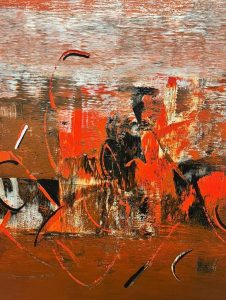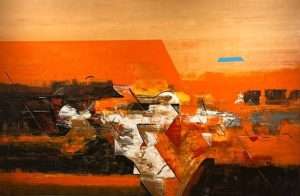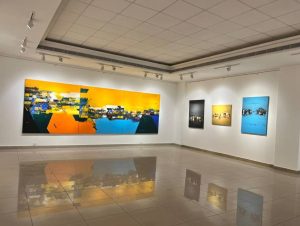Pallavi Baheti
Art exists as a single-minded concentrated attention beyond individuality. It does not exist for its own sake, it exists for an experience. Indian artists do not seek an illusion of nature; rather they try to create a truthful suggestion of character of the subject. In the words of Ananda Coomaraswamy, ‘Art is neither imitation nor illusion. It is an act when the seen and the seer meet in an act of transcending distinction.’
Vivek Nimbolkar, an artist born in 1977 and brought up in Mumbai, Maharashtra, India developed an early interest in art and designing inspired by his mother’s embroidery. He holds five professional degrees in art education; Masters in Art (Painting), Diploma in Art Education, G.D. in Art Painting, Art Teacher Diploma and Masters of Art (Indology). From a series of realistic works, the artist has transcended into abstract array of painting.
The artist recently exhibited his new creations at the State Art Gallery of Hyderabad by the title, ‘Forms; Finding Form in the Formless’. To which the writer questions – where do the abstract formless forms in the paintings by Vivek Nimbolkar lie? What is his creative practice? How does an artist reach a state of flow where every stroke sings a lyrical melody?

To understand a formless form, is to question, What is form?
A form or Akriti, quite literally means a visible form, shape, appearance or something tangible. However, philosophers such as Plato argue the intangibility within forms, ‘Forms, such as beauty, are more real than any objects that imitate them. These forms are timeless whereas the physical things are in a constant state of change.’ The artist acknowledges the tangible and the intangible forms within nature, he further comments, ‘I imprint my impressions of nature onto my canvases, and these works are my imitations.’ On a closer inspection, his paintings converse through lines, symbols, and figures such as circles, half circles, triangles and square, however further when they are zoomed in, there nothing but pixels of paints put together in a multitude of movement with the purpose to simply create.
To understand the abstraction within his works is to question, What is abstraction?
Webster’s dictionary defines Abstraction as art abstracted from reality, in which designs or forms may be definite and geometric or fluid, a generic term that encompasses various non-realistic contemporary schools.
‘Remember that a picture before being a battle horse, a nude woman or an anecdote – is essentially a flat surface covered with colors arranged in a certain order.’
– Maurice Denis
Philosophy of abstraction focuses on abstraction as a form of cognition, mentally isolating properties of an object from others. Both the process and result are called abstraction.
At an inspection of Vivek Nimbolkar’s early works, realism is traced, an imitation of what is seen to the naked eyes in the nature. However with time, skill and practice, visible realism shredded off and artistic impressions drenched in. From a state of Pratyaksha (material embodiment) to a state of Paroksha (perceptive embodiment), the artworks and the artists transformed. Pratyaksha, means that which is visible to the eye and Paroksha means knowledge meditated by sensory intellectual apparatus.
Lastly, What is the creative practice and where does an artist take a pause for an abstract creation?
Nimbolkar’s early morning walks everyday connects him with nature, mentally, physically and spiritually. These impressions take an abstract form on his canvas. His influence in this journey is credited to masters such as Willem de Kooning, Richard Diebenkorn and Jackson Pollock.
As a full time, artist, he strictly dedicates 8-10 hrs every day to his creations and majorly get done before evenings. He feels it’s essential for his paintings to soak in the daytime sunlight as it helps the viewer’s gaze with vibrancy and freshness.
He has been awarded with National Award by Government of Telangana, Hyderabad (2021), Colours Wings Masters, Calcutta (2020), Lokamanya Tilak Award, Pune (2019) and many more just to name a few. He started exhibiting his works in 1997 and till now has participated in more than 70 shows. His major solo exhibitions were Gandhi Art Gallery, Buldhana (1998), Hussain Art Gallery, Pune (2002), ICA Gallery, Jaipur (2021) and Art2day gallery, Pune (2022).
References
- The transformation of Nature in Art by Anand Coomaraswamy
- Plato’s theory of form by Daniel Lehewych
- Abstraction in Indian Painting : Post Independence Era by Badar Jahan
- What is abstract art? – Tate
- Art Fundamentals – Theory and Practice
- Multiple conversations with the artist
.







